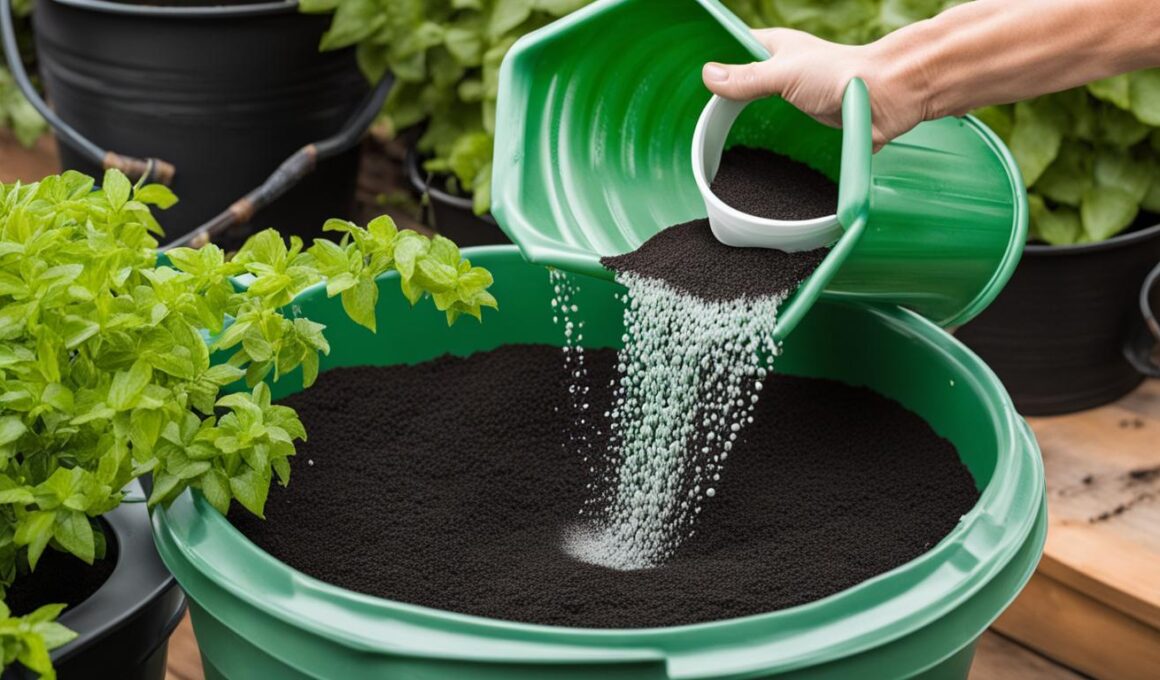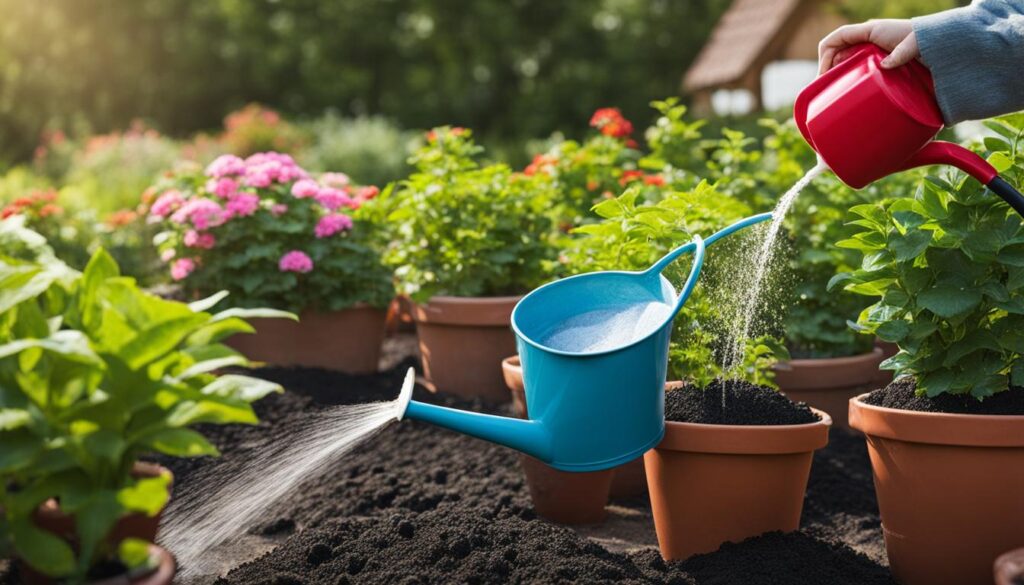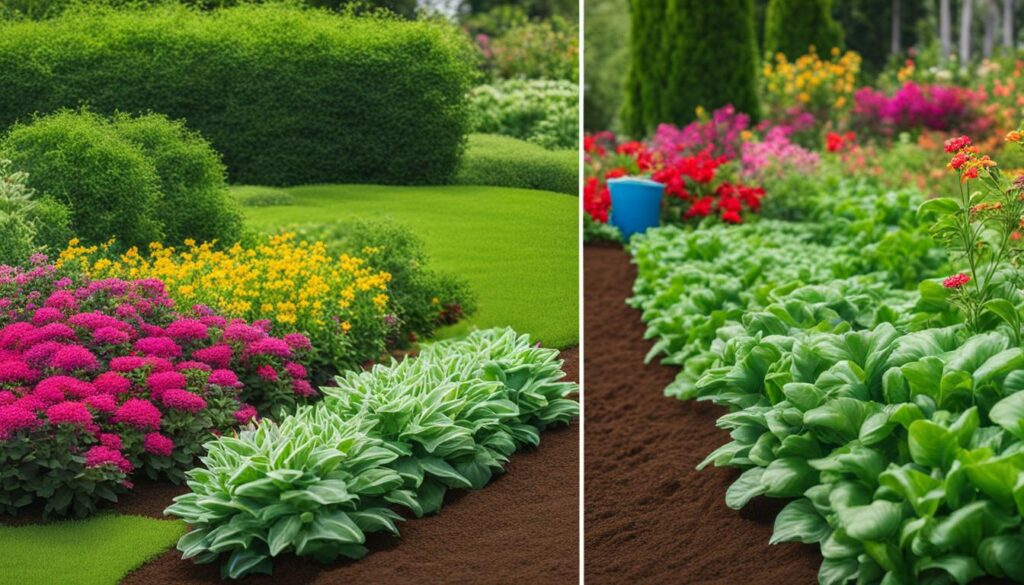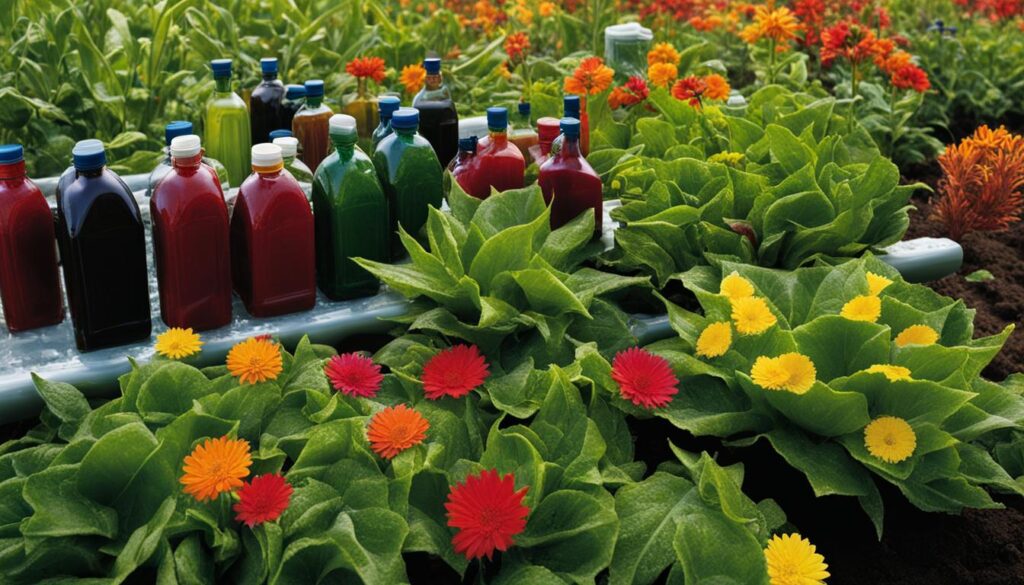Are you looking for a fast-acting fertilizer solution that can provide immediate benefits to your plants? Converting granular fertilizer into liquid form might be the answer you’re looking for. Liquid fertilizer is especially effective for brand-new plants, seedlings, or plants with nutrient deficiencies. It can also be a game-changer in cold weather when microbial activity in the soil is slow and dry fertilizer breaks down slowly. The process of turning granular fertilizer into liquid is simple and can be done with ease. Let’s explore how you can do it.
Post Summary
- Converting granular fertilizer into liquid form is a simple process.
- Liquid fertilizer provides fast-acting benefits to plants.
- It is particularly useful for new plants, seedlings, and nutrient-deficient plants.
- Using liquid fertilizer in cold weather can improve plant health when microbial activity is slow.
- The resulting liquid can be applied to plants by spraying it on leaves or watering the root zone.
Why Convert Granular Fertilizer Into Liquid?
Converting granular fertilizer into liquid offers a multitude of benefits for your plants. Liquid fertilizer is fast-acting and provides nutrients to plants quickly, allowing for immediate health improvements. This makes it especially advantageous for new plants, seedlings, or plants with nutrient deficiencies. Additionally, liquid fertilizer is highly effective in cold weather when microbial activity in the soil is slow, ensuring that plants receive the nutrients they need to thrive. Think of it as an “energy drink” for your plants, giving them an immediate boost.
Using liquid fertilizer also has the added benefit of deterring dogs from being attracted to the smell of certain organic fertilizers. By converting your granular fertilizer into liquid form, you can reduce the risk of them digging or eating the fertilizer, ensuring the safety of your pets.
Overall, the advantages of converting granular fertilizer into liquid form make it a worthwhile investment for any gardener. From fast-acting nutrient delivery to the prevention of pet attraction, liquid fertilizer provides a convenient and effective option for plant nutrition.
How To Convert Granular Fertilizer Into Liquid
Converting granular fertilizer into liquid form is a simple process that can be done with both store-bought granular fertilizers and homemade fertilizer recipes. The method involves soaking the granular fertilizer in water and letting it sit for 24 hours. The ratio is usually 1 cup of fertilizer per gallon of water. During the soaking process, it is important to stir the mixture periodically. After 24 hours, the liquid can be strained to remove the solids, and the resulting liquid can be used as a fertilizer. The liquid can be applied directly to the root zone of plants or used for foliar feeding by spraying it on the leaves.
When converting granular fertilizer into liquid, it is essential to follow proper steps for optimal results. Start by selecting the right type of fertilizer suitable for the plants you are fertilizing. Ensure you have a clean container with a lid to hold the mixture during the soaking process. Measure the appropriate amount of granular fertilizer and water according to the recommended ratio. Stir the mixture well to ensure the fertilizer dissolves and mixes evenly with the water. After 24 hours of soaking, strain the liquid to remove any solids. The resulting liquid fertilizer is now ready to be applied to your plants.
Keep in mind that different fertilizers may have specific conversion ratios and soaking times, so it’s essential to follow the instructions provided by the manufacturer or the recipe you’re using. Additionally, it is recommended to use the liquid fertilizer within a few days of preparation to ensure the highest nutrient content and effectiveness. Regularly monitor the health and growth of your plants to determine the frequency and dosage of liquid fertilizer application for optimal results.
Steps to Convert Granular Fertilizer Into Liquid
| Step | Description |
|---|---|
| 1 | Select the appropriate granular fertilizer for your plants. |
| 2 | Measure the fertilizer and water according to the recommended ratio. |
| 3 | Place the fertilizer in a container with a lid. |
| 4 | Stir the mixture well to dissolve the fertilizer in water. |
| 5 | Let the mixture soak for 24 hours, stirring periodically. |
| 6 | Strain the liquid to remove any solids. |
| 7 | Apply the liquid fertilizer to the root zone or as a foliar spray. |
Converting granular fertilizer into liquid form provides an efficient way to deliver nutrients to your plants quickly. Whether you prefer store-bought fertilizers or homemade recipes, following the proper steps will ensure successful conversion and optimal plant health. With liquid fertilizer, you can provide your plants with the immediate boost they need for healthy growth and development.
Other Recipes for Liquid Fertilizer
If you’re looking for alternative options to convert granular fertilizer into liquid form, there are several homemade recipes you can try. These DIY liquid fertilizers provide additional choices for plant nutrition and can be easily made at home. Here are a couple of recipes to consider:
Making Liquid Kelp
One popular option is making liquid kelp fertilizer. To create this nutrient-rich liquid, you’ll need to soak kelp meal in water to create a paste. Dilute the paste with water until you achieve the desired consistency, and you’ll have a homemade liquid fertilizer that can be applied to plants. Liquid kelp is known for its high levels of growth-promoting hormones and essential nutrients, making it a great option for plant health.
Creating Liquid Fertilizer from Seaweed
Another homemade liquid fertilizer recipe involves using seaweed. Simply chop sea kelp and add it to water, allowing it to soak for a few days. The resulting liquid can then be used to water plants or applied as a foliar spray. Seaweed is rich in minerals and trace elements, providing added nutrition to your plants and promoting healthy growth.
By exploring these alternative liquid fertilizer recipes, you can find options that suit your specific plant needs and preferences. Experiment with different homemade fertilizers to discover what works best for your garden.
| Homemade Liquid Fertilizer Recipe | Ingredients | Instructions |
|---|---|---|
| Liquid Kelp | Kelp meal, water | 1. Soak kelp meal in water to create a paste. |
| 2. Dilute the paste with water to achieve desired consistency. | ||
| 3. Apply the liquid kelp fertilizer to plants. | ||
| Liquid Fertilizer from Seaweed | Chopped sea kelp, water | 1. Chop sea kelp and add it to water. |
| 2. Allow the mixture to soak for a few days. | ||
| 3. Use the resulting liquid to water plants or as a foliar spray. |
Benefits of Liquid Fertilizer
Liquid fertilizer offers numerous advantages over granular fertilizer, making it a popular choice among gardeners and farmers. The fast-acting nature of liquid fertilizer allows plants to quickly absorb nutrients, resulting in improved growth and overall health. The even distribution of nutrients in liquid fertilizer ensures that every drop provides the same ratio of essential elements, promoting balanced plant nutrition.
One of the key reasons to choose liquid fertilizer is its convenience and ease of application. Liquid fertilizer can be easily mixed with water and applied directly to the root zone of plants or used as a foliar spray. This makes it particularly suitable for new or struggling plants that require immediate nutrient availability. Liquid fertilizer is also highly effective in cold weather when microbial activity in the soil is slow, enabling plants to receive a quick nutrient boost.
“Liquid fertilizer provides an even distribution of nutrients and can be easily applied to the root zone or used as a foliar spray.”
Another benefit of liquid fertilizer is its versatility. It can be used for various types of plants, including both ornamentals and edibles. Liquid fertilizers are especially beneficial for starting and revitalizing lawns, as well as for vegetables that need a rapid nutrient uptake. Additionally, liquid fertilizer is an attractive option for those seeking to reduce the risk of pets being attracted to the smell of certain organic fertilizers.
Comparison Between Liquid and Granular Fertilizer
In order to fully understand the advantages of liquid fertilizer, it is important to compare it to granular fertilizer. While granular fertilizer provides long-lasting nutrient availability, liquid fertilizer offers fast-acting results. Granular fertilizer is cost-effective and environmentally friendly, making it suitable for established landscapes and heavy-feeding plants. On the other hand, liquid fertilizer is ideal for new or struggling plants that require quick nutrient delivery.
By combining both liquid and granular fertilizers, gardeners and farmers can benefit from the strengths of each form. This ensures a balanced nutrient supply to plants and allows for targeted nutrition based on specific plant needs. However, it is important to carefully apply both forms of fertilizer and avoid overuse or underuse to prevent any harm to the plants.
| Advantages of Liquid Fertilizer | Advantages of Granular Fertilizer |
|---|---|
| Fast-acting nutrient delivery | Long-lasting nutrient availability |
| Even distribution of nutrients | Cost-effective and environmentally friendly |
| Convenient and easy to apply | Suitable for established landscapes and heavy-feeding plants |
| Versatile and suitable for a wide range of plants | Stable and slow-release nutrient release |
Can You Use Both Liquid and Granular Fertilizer Together?
Combining liquid and granular fertilizers can provide a comprehensive approach to plant nutrition, capitalizing on the unique benefits of both forms. While granular fertilizers offer long-lasting nutrient availability, liquid fertilizers provide fast-acting and immediate results. By using both types simultaneously, you can ensure a balanced nutrient supply and address specific plant needs. However, it is important to apply them carefully and in appropriate measures to prevent any harm to the plants.
Granular fertilizers are typically slow-release and provide nutrients over an extended period. They are cost-effective and environmentally friendly, and they can be applied directly to the soil or incorporated during planting. On the other hand, liquid fertilizers deliver nutrients quickly and are especially beneficial for new or struggling plants. They can be applied to the root zone or used for foliar feeding, addressing nutrient deficiencies promptly.
Using both liquid and granular fertilizers together can have numerous benefits. The slow-release nature of granular fertilizers ensures continuous nutrient supply, while the fast-acting liquid fertilizers provide an immediate boost for plants. This combination can enhance overall plant health, encourage vigorous growth, and support optimal nutrient uptake. By understanding the advantages of each form of fertilizer and their specific applications, you can tailor your fertilization approach to meet the unique needs of your plants.
Comparing Liquid and Granular Fertilizers
| Aspect | Liquid Fertilizers | Granular Fertilizers |
|---|---|---|
| Nutrient Availability | Fast-acting, immediate results | Slow-release, long-lasting |
| Application Method | Can be sprayed onto leaves or watered into the root zone | Applied directly to the soil or incorporated during planting |
| Targeted Nutrient Delivery | Provides nutrients specific to plant needs | Offers a balanced nutrient supply for overall plant health |
| Usage Scenarios | Ideal for new or struggling plants, foliar feeding | Suitable for established landscapes, cost-conscious gardeners |
| Timing of Application | Beneficial in cold weather or when microbial activity is slow | Provides long-lasting nutrient availability over time |
When to Use Granular Fertilizer vs. Liquid Fertilizer
Choosing between granular and liquid fertilizer depends on the specific needs of your plants and the desired results. Granular fertilizer is typically used when long-lasting nutrient availability is required, such as in established landscapes or for heavy-feeding plants. It provides a slow-release of nutrients, ensuring a steady supply over time. Granular fertilizer is cost-effective and environmentally friendly, as there is no risk of runoff or leaching. It allows for convenient and precise application, especially when using spreaders or sprayers.
Liquid fertilizer, on the other hand, is beneficial for quick and immediate nutrient delivery. It is ideal for new or struggling plants that require a boost in health. Liquid fertilizer can be applied directly to the root zone or used as a foliar spray for faster absorption. It is also effective in cold weather when microbial activity in the soil is slow. Liquid fertilizer provides an even distribution of nutrients, as every drop contains the same ratio of essential elements.
To make an informed decision, consider the specific requirements of your plants and the timing of fertilization. If you have established landscapes or plants that need long-lasting nutrition, granular fertilizer is the preferred choice. However, if you have new plants or need quick results, liquid fertilizer is the way to go. You can also use a combination of both forms, applying granular fertilizer for sustained nutrition and liquid fertilizer for immediate benefits.
Granular vs. Liquid Fertilizer
| Factors | Granular Fertilizer | Liquid Fertilizer |
|---|---|---|
| Application | Convenient and precise, suitable for spreaders or sprayers. | Direct root zone application or foliar spray for faster absorption. |
| Nutrient Release | Slow-release, providing long-lasting nutrient availability. | Fast-acting, delivering quick results and immediate plant health benefits. |
| Distribution | Even distribution of nutrients throughout the soil. | Every drop contains the same ratio of essential elements. |
| Use Case | Established landscapes, heavy-feeding plants. | New or struggling plants, cold weather conditions. |
| Cost and Efficiency | Cost-effective, environmentally friendly, less risk of runoff or leaching. | Requires careful application, higher cost per nutrient unit. |
Best Liquid Fertilizer Options
When it comes to choosing a liquid fertilizer for your plants, there are several top options available. These recommended liquid fertilizers provide the best plant nutrition to promote healthy growth and optimal yields. Whether you’re looking for nitrogen supplementation, overall nutrient-rich fertilizers, or specialized formulas, these products deliver excellent results.
| Fertilizer | Key Features |
|---|---|
| Ammonium Sulfate Fertilizer 21-0-0 | A water-soluble crystalline compound that provides nitrogen supplementation for nitrogen-deficient soils and lawns. |
| Blossom Green 2-6-8 | A nutrient-rich fertilizer that promotes growth and health, especially during seeding, vegetative growth, and budding stages. |
| Boric Acid Fertilizer | A water-soluble form of boric acid that supports plant growth and production, ideal for crops with boron deficiency. |
Ammonium Sulfate Fertilizer 21-0-0 is a versatile choice that effectively boosts nitrogen levels in deficient soils and lawns. It ensures vigorous plant growth and deep green foliage. Blossom Green 2-6-8, on the other hand, is a well-balanced fertilizer that provides essential nutrients for all stages of plant development. It helps plants establish strong roots, encourages lush foliage, and promotes abundant flowering and fruiting. Lastly, Boric Acid Fertilizer is an excellent option for crops with boron deficiencies. It enhances cell wall development, improves nutrient uptake, and ultimately enhances overall plant growth and productivity.
When using these liquid fertilizers, always follow the manufacturer’s instructions for proper application rates and frequency. Be mindful of the specific needs of your plants and adjust the fertilization schedule accordingly. With the right liquid fertilizer, you can provide your plants with the best nutrition they need for healthy and thriving growth.
Note:
“Choosing the right liquid fertilizer can make a significant difference in the health and productivity of your plants. These recommended options provide targeted nutrients and are formulated for optimal plant growth. By using these top-quality liquid fertilizers, you can ensure that your plants receive the best nutrition for vibrant and fruitful results.”
Conclusion
In conclusion, converting granular fertilizer into liquid form offers numerous benefits for plant nutrition. Liquid fertilizer delivers nutrients quickly, making it ideal for new plants, seedlings, and those with nutrient deficiencies. It is also effective in cold weather when soil microbial activity is slow. By following a simple process of soaking the granular fertilizer in water for 24 hours and straining out the solids, you can create a liquid fertilizer that can be applied directly to the root zone or used for foliar feeding.
However, it is important to note that both liquid and granular fertilizers have their advantages and should be chosen based on your plants’ specific needs. Granular fertilizer is better suited for long-lasting nutrient availability in established landscapes or heavy-feeding plants. On the other hand, liquid fertilizer provides quick results and is beneficial for new or struggling plants. Understanding the differences and benefits of each form will help you make informed decisions for optimal plant nutrition.
Whether you choose to convert granular fertilizer into liquid or use both forms in combination, the goal is to provide balanced and targeted nutrition to your plants. By doing so, you can ensure healthy and thriving plants that produce vibrant blooms and abundant harvests. Consider your plants’ requirements, timing of fertilization, and desired results to determine the best approach for your gardening needs.
Can Liquid Fertilizer Increase Nutrient Uptake in Nutrient Film Technique?
Liquid fertilizer can improve nutrient uptake in nutrient film technique systems. Some pros of using liquid fertilizer in NFT include easy application and quicker nutrient absorption. However, cons such as the potential for inconsistent nutrient delivery and the risk of clogging should be considered before implementation.
FAQ
How do you turn granular fertilizer into liquid?
Soak the granular fertilizer in water for 24 hours, then strain out the solids to obtain the liquid fertilizer.
Why should you convert granular fertilizer into liquid?
Converting granular fertilizer into liquid form offers advantages such as fast-acting nutrient delivery, suitability for cold weather, and reduced attraction for pets.
How do you convert granular fertilizer into liquid?
Soak the granular fertilizer in water for 24 hours, stirring periodically. Afterward, strain out the solids and use the resulting liquid to fertilize plants.
Are there other recipes for liquid fertilizer?
Yes, you can make liquid fertilizer from ingredients such as kelp meal or seaweed by soaking them in water and diluting the mixture.
What are the benefits of using liquid fertilizer?
Liquid fertilizer is fast-acting, provides an even distribution of nutrients, and is easy to handle and apply. It is particularly beneficial for new or struggling plants and for foliar feeding.
Can you use both liquid and granular fertilizer together?
Yes, using both forms of fertilizer can provide a balanced nutrient supply to plants and address specific needs.
When should you use granular fertilizer vs. liquid fertilizer?
Granular fertilizer is typically used for long-lasting nutrient availability in established landscapes or for heavy-feeding plants. Liquid fertilizer is beneficial for quick nutrient delivery, new plants, and foliar feeding.
What are some recommended liquid fertilizer options?
Some effective liquid fertilizer options include ammonium sulfate fertilizer 21-0-0, Blossom Green 2-6-8, and boric acid fertilizer in water-soluble form.
What is the conclusion about using liquid fertilizer?
There is no conclusion provided for this section.












